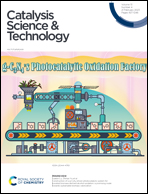Identification of structural changes in CaCu3Ti4O12 on high energy ball milling and their effect on photocatalytic performance†
Abstract
The perovskite CaCu3Ti4O12 is known for its ability to photocatalytically degrade model dye molecules using visible light. The influence of ball milling preformed CaCu3Ti4O12 on the catalysts structure and performance in the degradation of rhodamine B and the antihistamine cetirizine hydrochloride, which does not absorb light in the visible region, was investigated. The surface area of CaCu3Ti4O12 increased from 1 m2 g−1 to >80 m2 g−1 on milling with a retention of 96% CaCu3Ti4O12 phase purity, as determined by X-ray diffraction and extended X-ray absorption fine structure analysis. Multiple characterisation techniques showed an increase in structural defects on milling, including, for the first time, X-ray absorption near edge spectroscopy which showed changes in the local electronic structure from the perspective of Cu and Ti. Photocatalytic degradation was notably higher with the milled sample than that observed for the as-synthesized sample, even after normalisation for surface area, with a doubling of surface normalised rate constant from 4.91 × 10−4 to 9.11 × 10−4 L min−1 m2 for rhodamine B degradation and a tripling for cetirizine hydrochloride degradation from 2.64 × 10−4 to 7.92 × 10−4 L min −1 m−2. The improvement in catalytic performance can be correlated to the defects observed by X-ray absorption spectroscopy.



 Please wait while we load your content...
Please wait while we load your content...